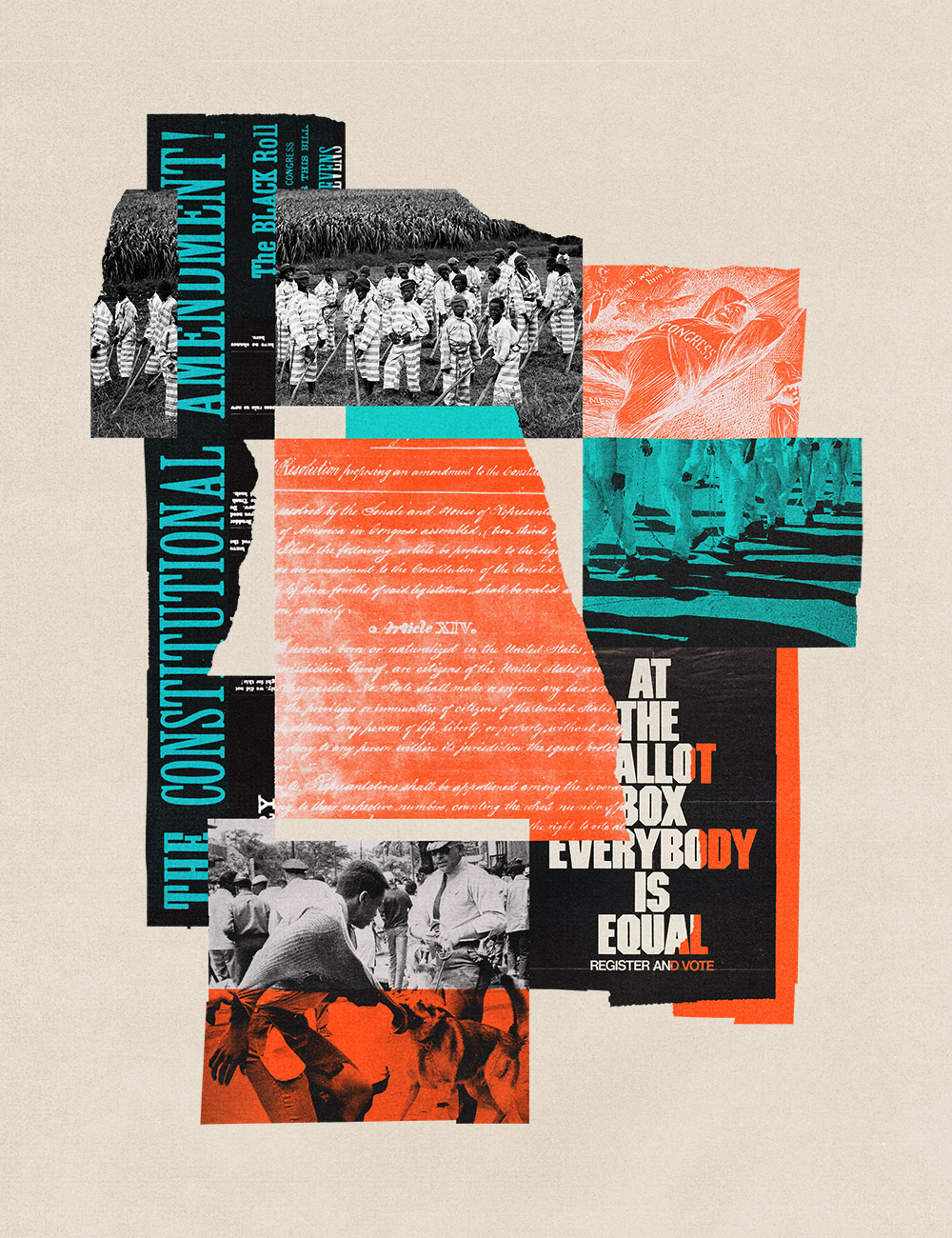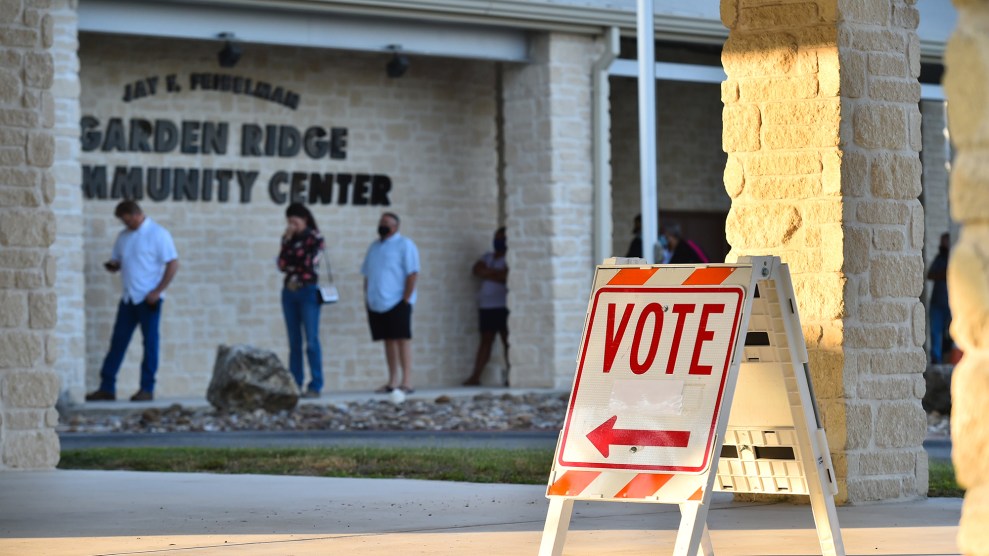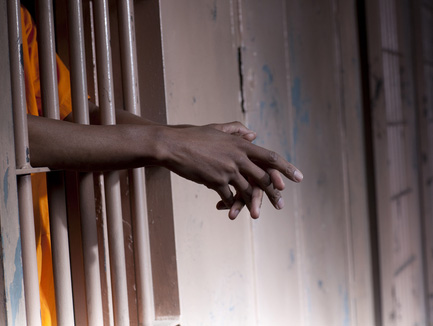In 1866, an Army officer named Robert Avery was stationed in North Carolina when he began hearing disturbing reports: Former rebels were rounding up as many Black men as they could find, dispensing summary justice, and whipping them in public view. Avery, an agent of the Freedmen’s Bureau there, alerted his superiors in Washington. The press got hold of his dispatch and began to chronicle the situation. Harper’s Weekly told of 500 people in Raleigh gathering to watch “the public whipping of colored men.”
The whippings were about more than bloodlust. They served a political purpose. Under North Carolina law, a crime punished by public whipping would cost the offender the right to vote. The white rebels plotted to “seize negroes, procure convictions for petty offenses punishable at the whipping post, and thus disqualify them forever from voting in North Carolina,” Avery reported. He had overheard members of the state legislature celebrating that it would “head off Congress from making the negroes voters.” One had bragged, “We are licking them in our part of the State and if we keep on we can lick them all by next year, and none of them can vote.”
Just a few months earlier, Congress had passed the 14th Amendment and sent it to the states for ratification. In the second section of the amendment, the antislavery Republicans sought to enfranchise the freed men in the South. But rather than affirmatively extend the franchise, they devised a way to punish states that did not allow Black men to vote: Should a state disenfranchise its Black men, its congressional delegation would be reduced in proportion to the number of those excluded from the vote. But the architects of this approach left a loophole: States would not see their delegations reduced for citizens disenfranchised “for participation in rebellion, or other crime.” In North Carolina, white supremacists decided to turn every Black man they could into a convict, taking away his right to vote while preserving their power in Congress.
Or other crime. Three small words that continue to shape America today. It is a great irony of our history that the 14th Amendment, which enshrined in the Constitution the promise of equal protection under the law, is today the principal source of Black disenfranchisement. But there’s no reason to accept this fate. At a time when the public is increasingly aware of modern attempts at suppression, the tools for resurrecting the fundamental right to vote are waiting to be put to use. Our future could depend on how seriously we decide to take the rest of the words in Section 2.

The white supremacists in North Carolina had figured out something important: The 14th Amendment was a weapon that could be turned against itself if Congress and the courts did not intervene. And that’s precisely what happened throughout the South. Black criminality was constructed to fit the needs of the prevailing racial order. Freed from federal oversight after Reconstruction, most Southern states by the 1900s had rewritten their constitutions to deny Black people the vote through nominally race-blind provisions, including expanded criminal disenfranchisement. These measures, alongside poll taxes, literacy tests, grandfather clauses, fraud, registration restrictions, and vigilante violence, were part of the toolkit used by white supremacists to maintain a system of racial subordination. Felon disenfranchisement was not strictly a regional phenomenon—more than 80 percent of states had felon disenfranchisement laws on the books by the end of the 19th century—but the South became its epicenter after Reconstruction, continuing into the age of mass incarceration.
The rest of Section 2 was more or less ignored. Congress never invoked its penalty, and instead turned a blind eye to the mass disenfranchisement that more deeply entrenched white supremacy. The curtailment of Black voting rights inflated the white supremacists’ power in Washington. Political scientist Richard Valelly estimates that it gave white Southerners an extra 25 seats in the US House in the first half of the 20th century. Black disenfranchisement effectively created a one-party system in the South that gave seniority to Jim Crow lawmakers in Congress, placing them atop powerful committees where they stymied economic opportunities for Black people, most significantly in the New Deal. Failure to enforce the penalty, Valelly argues, contributed to the election of Woodrow Wilson in 1912. An unrepentant racist, Wilson oversaw the segregation of the civil service, effectively federalizing Jim Crow, and the transformation of the District of Columbia into a stratified Southern-style capital. It’s impossible to imagine how else our history might have unfolded had Black interests been allowed a voice in the federal government.
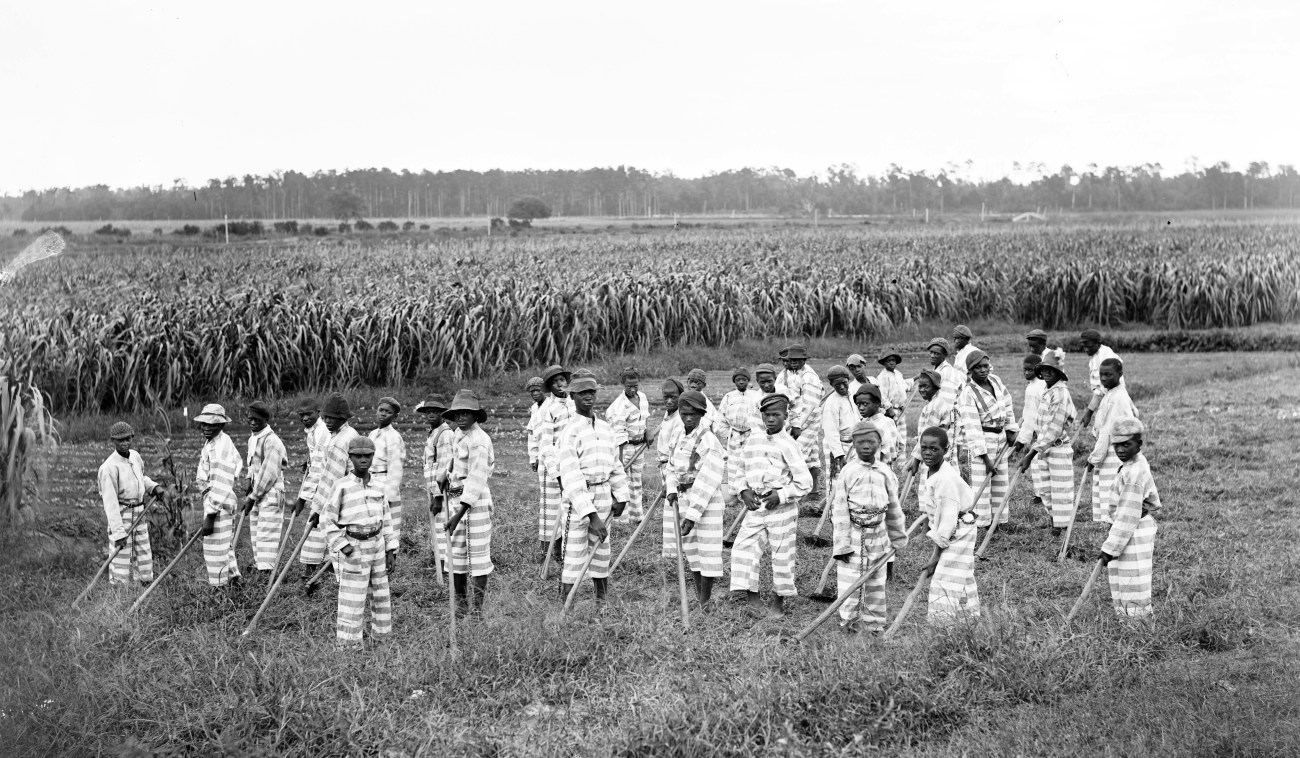
Chain gang, 1903.
Photo 12/Universal Images Group/Getty
In 1965, the Voting Rights Act did what Congress had failed to do with Section 2 by finally protecting Black Southerners’ right to vote. During its second Reconstruction, the nation banned poll taxes and literacy tests, and began blocking myriad local voting restrictions. Voting, Congress and the Supreme Court declared in a series of landmark laws and decisions, was a fundamental right. But like some sort of tragic flaw, the ambivalence built into Section 2 would continue to shape the plot of American history.
In 1974, the Supreme Court, now in conservative hands, ruled that Section 2 allowed states to disenfranchise ex-offenders permanently. The opinion was both a product and producer of the era of racial retrenchment that worked to beat back the gains of the ’60s. This was the dawn of mass incarceration. Within decades, millions of Black Americans had been incarcerated and stripped of the right to vote, some for the duration of their sentences, many for the rest of their lives. In addition to warping local politics, this mass disenfranchisement had profound national effects. In 2000, George W. Bush was elected by 537 votes in the state of Florida, a state that had permanently banned an estimated 827,000 people at that time from voting, a disproportionate number of them Black. In 2016, Hillary Clinton lost the state by about 113,000 votes, while nearly 1.5 million Floridians were disenfranchised—including 21.4 percent of eligible Black voters, according to estimates from the Sentencing Project. Again and again the history of the country has turned on those three forgotten words in the Constitution.
In 2020, despite Florida voters having passed in 2018 a constitutional amendment to end permanent disenfranchisement for most crimes, the state continued to disenfranchise nearly 900,000 formerly incarcerated individuals. It did this by demanding they first pay off fines and fees associated with their convictions, what voting rights advocates called a modern-day poll tax. Across the country but concentrated in the South, 5.17 million people remain disenfranchised for a felony conviction, including 1 in 16 eligible Black voters—nearly four times the rate for the non-Black population. Eleven states disenfranchise at least 10 percent of their Black populations. In Tennessee, it’s 21 percent. Section 2 was designed to combat racial disenfranchisement. Instead, it is used to justify the greatest voter suppression scheme in modern times.

None of this had to happen. The country made the choice to allow Section 2 to be used for evil. The roots of this decision are important, not least because they demonstrate that some pragmatic compromises made in the name of unity have a way of bringing about radical injustices. After the Civil War, the 13th Amendment ended slavery. It also created an immediate problem for the Republican Party, then the antislavery party of the North. Before the war, the Constitution had counted slaves as three-fifths of a person for apportioning congressional delegations, giving slave states extra representation (another disastrous compromise). Now, every person counted equally. By withholding the franchise from former male slaves, the South, buoyed by their number but unencumbered by their votes, was poised to return to the Union even more powerful than before.
The obvious solution was to enfranchise Black men, and Radical Republicans—who believed in racial equality and wanted to punish the rebels—fought for this. But moderate Republicans balked, fearing backlash from white constituents who had no interest in expanding the Black vote. Additionally, most Northern states had also disenfranchised their Black populations, and lawmakers didn’t want to change the rules in their own backyards.
So Section 2 was a compromise to address the immediate problem of Southern representation. The Radical Republicans voted for it while lamenting it as a betrayal. “It was a scheme of cold-blooded treachery and ingratitude to a people who had contributed nearly two hundred thousand soldiers to the armies of the Union,” George Julian, a Radical Republican representative from Indiana, recalled in his memoirs. “To recognize the authority of these states to make political outlaws of their colored citizens and incorporate this principle into the Constitution of the United States, was a wanton betrayal of justice and humanity.” Julian preferred an amendment that would affirmatively extend the right to vote to Black Americans and, far ahead of his time, to women. On the first of these, his colleagues would quickly come around.
Some Radical Republicans also predicted Section 2’s practical deficiencies. After the passage of the 13th Amendment ending “involuntary servitude” except when convicted of a crime, the rebel states had quickly erected Black Codes to criminalize the former slave population and put them back into bondage on plantations through what became the convict-leasing system—a loophole that persists to this day in the widespread practice of prison labor. In January 1866, Illinois Rep. John Farnsworth warned that the rebels may pull the same trick again when it came to voting: “They may provide that no man shall exercise the elective franchise who has been guilty of a crime and then they may denounce these men as guilty of a crime for every little, imaginary, petty offense.” But many of his colleagues ignored this warning.
Felon disenfranchisement had a long history going back to English common law. “Disenfranchising for crime was incredibly common back then,” says Pippa Holloway, a history professor at the University of Richmond and the author of Living in Infamy: Felon Disfranchisement and the History of American Citizenship. Those convicted of serious offenses were considered unworthy of the right to vote—a view of suffrage eagerly taken up on this side of the Atlantic. But “the people convicted of serious crimes in the 1860s, 1870s, and 1880s were a really small number of people.” As North Carolina’s whipping scheme revealed, the framers of Section 2 had underestimated the South’s dedication to white supremacy. The list of felonies in Southern states quickly expanded in response to Section 2, and countless people have lost the right to vote for offenses that the states had once reckoned trivial. Florida, still the state with the highest number of disenfranchised felons, illustrates this sea change. In 1866, the state established county criminal courts with jurisdiction over “larceny…malicious mischief, vagrancy, and all misdemeanors,” and “all offences against Religion, Chastity, Morality, and Decency,” targeted at Black citizens. Two years later, it established that all felonies and “infamous crimes” would lead to disenfranchisement, again with the aim of stripping the newly freed slaves of their voting rights. Florida’s prison population immediately soared, almost tripling from 1880 to 1890.
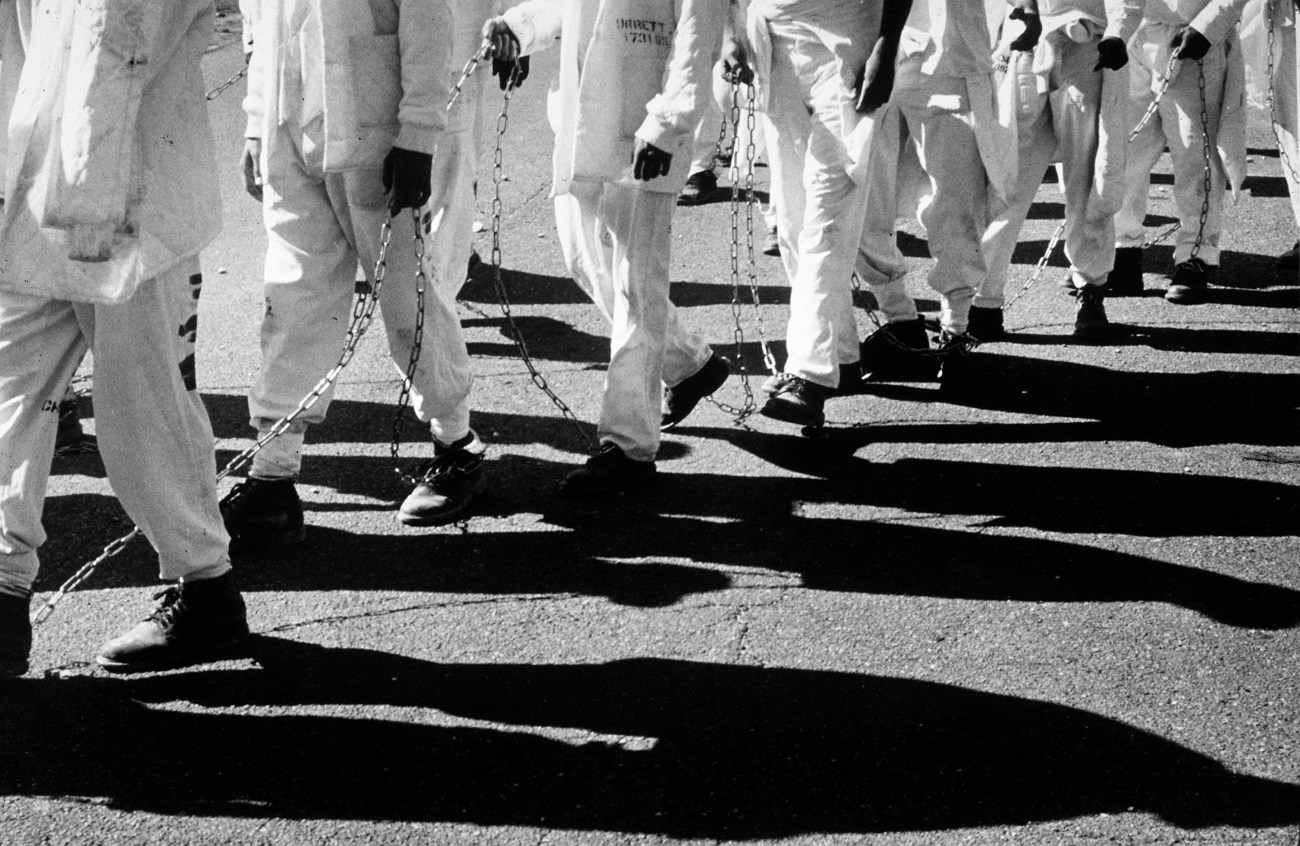
A chain gang at Limestone Correctional Facility in Harvest, Alabama.
Andrew Holbrooke/Corbis/Getty
The 14th Amendment had scarcely passed to the states for ratification in June 1866 when Congress realized its insufficiency. After Abraham Lincoln’s assassination, President Andrew Johnson began to show his true colors as a racist bent on undercutting the project of Reconstruction. He installed all-white governments in the former Confederate states, which created a new system of bondage for the freed slaves. These Johnson governments, dedicated to white supremacy, rejected the 14th Amendment, and Johnson offered $20,000 of his own money to the campaign against it. Within months of its passage, most Republicans realized that Section 2 would not entice the Confederate states to let freed men vote. They began to favor what had been unthinkable just a few months before: the required enfranchisement of Black men.
“It was rebel desperation which saved the negro,” Julian wrote, recalling the change in sentiment toward Section 2 in December 1866, “for if the xiv Amendment had been at first accepted, the work of reconstruction would have ended without conferring upon him the ballot.” Three months later, in March 1867, a Republican-dominated Congress passed the Military Reconstruction Act, paving the way for the replacement of white supremacist regimes with biracial governments elected by white and Black men. At least 800,000 freed men gained the right to vote. The act also attempted to tamp down on the practice of disenfranchising Black men for petty offenses, stipulating that the franchise could be removed only for crimes viewed historically as serious—“for participation in the rebellion or for felony at common law.”
The readmission acts that subsequently allowed rebel states back into the Union by 1870 again stipulated that felon disenfranchisement was intended to be a narrow exception: “except as a punishment for such crimes as are now felonies at common law, whereof they shall have been duly convicted, under laws equally applicable to all of the inhabitants of said state.”
In 1869, just three years after refusing to affirmatively force Black suffrage on the states, Congress did just that, passing the 15th Amendment. “This is a period when people’s ideas are in rapid flux,” says Eric Foner, a preeminent historian of Reconstruction. “People who, at the time of the 14th Amendment, said we cannot tell the states what to do about voting, two or three years later have changed their mind and they’re now considering voting a natural right which no state can take away from you.” They also now believed, crucially, “that the federal government has a right to intervene to protect the right to vote.”
The three amendments of the Reconstruction era radically transformed American life and the role of the federal government. The final section of each amendment grants Congress the power to enforce the amendments with appropriate legislation. Whereas the first clause of the Bill of Rights, drafted some 80 years earlier, was the injunction that “Congress shall make no law,” now the three Reconstruction Amendments gave the state permission to act: “Congress shall have the power to enforce…”
Foner sees the three amendments as part of one working whole: the rapidly evolving project of resolving the just emancipation of 4 million slaves and the reunification of the country. “By putting into the Constitution the notion that Congress shall have the power to enforce this, that guarantees that it’s an ongoing process,” Foner says. “They anticipate that Congress will have to come back and back and back and figure out, ‘Okay, we didn’t anticipate this would happen. Now we’re passing a law to deal with it under the 14th Amendment or under the 15th Amendment.’ They left themselves the power to deal with any oppressive measures that came along.”
Now would be a good time to resurrect that power.

Felon disenfranchisement is the most significant form of voter suppression today. But it is not the only one. In 2013, the Supreme Court struck down a key provision of the 1965 Voting Rights Act under the antebellum logic that states should have free rein in setting qualifications for voting, effectively ignoring the Reconstruction Amendments. In the years since, states under the control of the Republican Party (now the party of white voters, particularly in the South) began to restrict ballot access through voter ID laws, poll closures, and purges of the voter rolls, to name a few examples. In 2020, as millions attempted to vote by mail during the coronavirus pandemic, Republicans sought to make voting harder. In Texas, Republicans tried to invalidate ballots cast at drive-through voting sites. In North Carolina, a signature match law for absentee ballots disproportionately resulted in Black voters’ ballots being tossed. In Pennsylvania, a court ruled that absentee ballots would be invalid if they had not been placed in so-called “secrecy slips” before being placed in their envelopes. If a fundamental right is negated by the lack of an extra envelope, is it really fundamental?
There’s power in the Reconstruction Amendments to upend all of these voter suppression schemes. “There’s a lot of latent power, unused but still there, in the 13th, 14th, and 15th Amendments and in the legislation that was passed to enforce them,” says Foner. But Section 2, long forgotten, is particularly enticing in this moment. “It was put in the Constitution precisely to deal with what we are facing today, significant disenfranchisement of American citizens by the states. And that they have to pay a penalty if they’re trying to do that.”
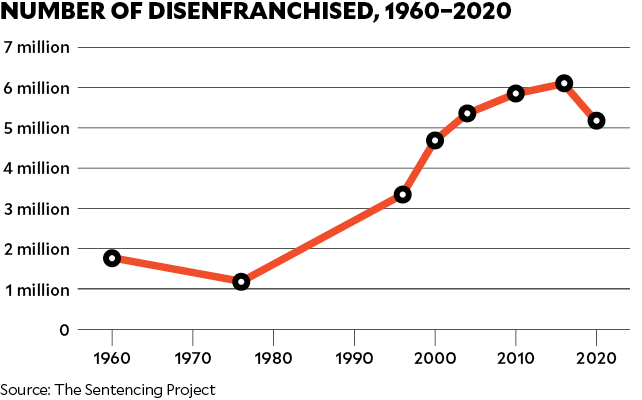
For 150 years, Section 2 was left dormant, except to disenfranchise convicted offenders. In 1869, Congress considered limiting the representation of Northern states that banned Black suffrage, but chose not to because the 15th Amendment was on the verge of ratification. The fact that the 15th Amendment enshrined what Section 2 did not leads Gabriel Chin, a professor at the University of California, Davis, School of Law, to argue that Section 2 was actually repealed by the 15th Amendment—a failed experiment that was quickly replaced with an explicit ban on racial discrimination in voting. Chin further argues that Congress’ failure ever to enforce Section 2 constitutes evidence of its repeal. But Congress did attempt to enforce Section 2 at least twice. In the early 1870s, there was a failed effort to reduce representation from Southern states. After Reconstruction, several Southern states passed constitutions that effectively banned Black men from voting, leading some Republicans in Congress to attempt again to use Section 2 to reduce the number of delegates from those states at the turn of the century, but that effort also failed. In 1904, use of Section 2 was included in the Republican Party’s platform. And in 1921, W.E.B. Du Bois wrote an editorial in the NAACP magazine, The Crisis, urging Congress to use Section 2 against Southern states. But neither party “was willing to stand up for the rights of Black people,” says Foner. “It was racism, fundamentally.”
Resurrecting Section 2 in the name of voting rights would restore its original purpose: to be a hammer against voter suppression, not carte blanche for felon disenfranchisement. This is how it should have been applied all along.

According to scholars I spoke with, there is in fact no reason that Congress couldn’t—and shouldn’t—begin shrinking a state’s delegation if it disenfranchises some of its citizens. But what if Congress could take less drastic measures to ensure the right to vote instead?
What’s appealing about Section 2 is that its language in defense of voting rights is the most powerful in the Constitution. Section 2 doesn’t actually rely on proof of racial discrimination to kick in. It doesn’t even require any bad intentions. All that matters to trigger Section 2 is if “the right to vote…is denied…or in any way abridged.” And Congress shall have the power to enforce it. Justice Ruth Bader Ginsburg laid out this road map in her dissent to the 2013 Shelby v. Holder decision that gutted the Voting Rights Act. Though she did not name Section 2 directly, she indicated that the power to enforce the constitutional amendments that mention voting gives Congress “the lead rein in making the right to vote equally real for all U.S. citizens.”
Today, lawmakers couch their efforts at voter suppression as procedural matters of election administration: extra hurdles a voter must clear to successfully vote. Harking back to the old states’ rights pretext, courts allowed these measures to stand in the runup to the 2020 election, even as Democratic lawyers protested that thousands would lose the ability to vote. “We are being absolutely deferential to states on the question of the conditions under which voting occurs,” says Franita Tolson, an expert on constitutional and election law at the University of Southern California Gould School of Law. “By getting this analysis away from intent, [Section 2] actually can do a lot for protecting the right to vote more generally. The courts are still looking for bad actors.” Instead, they should be looking at how voting requirements disenfranchise eligible voters. But judges repeatedly view requirements such as ID laws as entirely within the power of the legislature no matter their effect on voters.
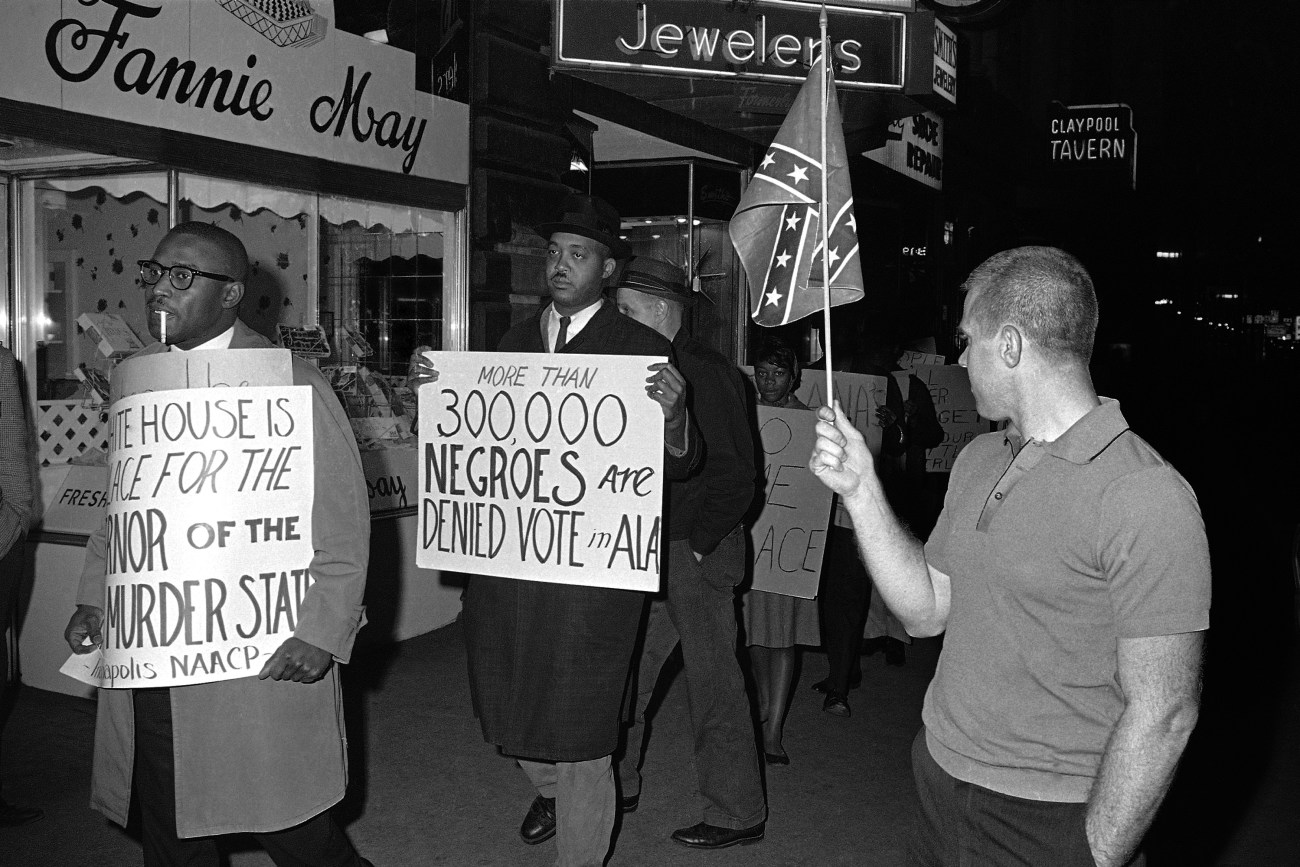
A 1964 demonstration in front of an Indianapolis hotel where then–Alabama Gov. George Wallace was staying.
Bob Daugherty/AP
Tolson believes that Section 2, along with the power to enforce it, gives Congress wide latitude to protect against disenfranchisement and onerous voting requirements. Shrinking a state’s delegation is the upper bound of what Congress can do, she argues. It can also take less intrusive measures, such as passing laws to ban restrictive voting laws, setting federal standards for ballot access, and resurrecting the federal oversight of jurisdictions with a history of disenfranchisement that the Supreme Court cut out of the Voting Rights Act. This is a vision of the power of the Reconstruction Amendments that would not sit well with our current Supreme Court, with its retrograde record on voting rights. But a Congress dedicated to voting rights and the spirit of the Reconstruction Amendments should not be deterred by a hostile court, even if it stands in the way. For one thing, any conservative court decision seeking to preserve felon disenfranchisement would have to manage a tricky feat: cutting the knees out from under Section 2 without upending “or other crime,” too. There is also a moral imperative. To compromise at all on this score is to relinquish Congress’ power to ensure a fair democracy. It is to accept the premises of the Confederate dead-enders—that some people are less than others and thus less deserving of a full grant of citizenship.
But reanimating Section 2 also means dealing with disenfranchisement. The drafters of Section 2 specifically sanctioned felon disenfranchisement and they declined repeatedly to take it off the table in the Reconstruction Act and readmission acts, as well as in the 15th Amendment. “If they explicitly endorsed this specific restriction, then how can it be in the spirit of their politics to overturn it?” says Alec Ewald, an expert in felon disenfranchisement at the University of Vermont. His answer is in the moral intentions of the framers of the 14th Amendment. “It’s hard for me to imagine a Republican from the Reconstruction period who would not be horrified by the combination of social and political inequality that disenfranchisement brings about, because of their key concern for racial equality and political inclusion, as they understood those things at the time,” he says—though few supported women’s suffrage, and gaping exceptions found their way into the Reconstruction Amendments. For Ewald, the Supreme Court should have heeded the framers’ goal—political equality—without blindly protecting the specific carve-outs they found acceptable at the time.
But to fully understand the Supreme Court’s wrongheadedness in 1974 when it allowed felon disenfranchisement to go unchecked, you have to understand the court’s logic and how completely divorced it was from the intentions of those who wrote the 14th Amendment. The first section of the amendment promises equal protection and due process under the law. In 1974, the Supreme Court decided that Section 1 did not apply to Section 2; in other words, felon disenfranchisement was not constrained by the fact that it was disproportionately applied to Black people, and it did not matter that Black people were not treated equally under the law. In the years that followed, the court became, as Justice John Paul Stevens put it, a loyal foot soldier in the War on Drugs, expanding police powers and essentially greenlighting racial profiling. Law enforcement was, for all intents and purposes, outside the bounds of equal protection, and so was the disenfranchisement that stemmed from it. By the 1990s, the Supreme Court had held that little prevented cops from stopping drivers because they were Black; if a subsequent conviction cost those people their right to vote, that was likewise constitutional.
But the 14th Amendment never envisioned this reality. Section 1, with its promise of civil equality, was written to obliterate laws that applied disproportionately to one race. At the time, they were called Black Codes; now they are simply our criminal codes. The rebels in North Carolina, the ones who began seizing Black men, convicting them in all-white courts, and whipping them, thought they had found a loophole in the 14th Amendment. But the very system of justice they used to disenfranchise the freed slaves under Section 2 should have been invalidated by Section 1. Section 2 was supposed to operate in a world in which justice was applied equally, not a world of racial profiling and selective application of the law. As Congress made clear in the readmission acts, felon disenfranchisement was supposed to apply only “whereof they shall have been duly convicted, under laws equally applicable to all of the inhabitants of said state.”
Today, the Supreme Court allows felon disenfranchisement in a criminal justice system that is not equally applied. We are living completely within that North Carolina loophole. For a century and a half, Congress had untapped authority to punish voter suppression and inequality under the law—despite the Supreme Court’s decades-long efforts to preserve an apartheid system of justice. To ignore that latent power is to ignore the crisis itself.
